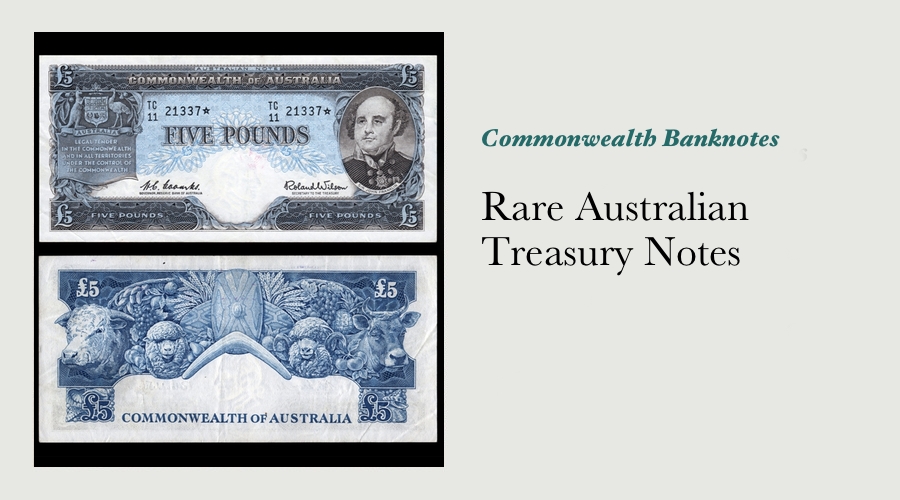Rare Australian Treasury Notes

There was an auction of world banknotes conducted by Spink and Son in London last month, it's been remiss of me not to make mention of it until now, particularly since the undoubted highlight of the sale was a set of six specimen banknotes dating back to the early years of the pre-decimal period in Australia. So important are these notes, they were accorded their own separate catalogue to the rest of the sale.
The specimen banknotes of Australia's Commonwealth period (between 1913 and 1966) are truly rare and enigmatic beasts - just knowing that they were printed before their respective production runs, and further that they circulated largely only within very tight circles of people within the banknote industry; the Commonwealth Goverment and other associated dignitaries adds to their appeal. I had occasion to research this entire series in detail some years ago when attempting to effect the sale of a complete set of Australian specimen notes from the QEII period, and have always wanted that information to get a wider audience. The sale of the specimens in the UK last month is a perfect opportunity to do so.
Wheny you're taking in the information below, please keep in mind that it's been compiled from all of the information that I had available at the time - it may well be that there are errors and or omissions included in it, so take it with a grain of salt. I approached the different types of specimen notes from a fresh perspective, and wanted to split them into different types to begin with. From what I have seen, there are 14 distinct “types” of pre-decimal specimen banknote – nine from the King George V period; four from the King George VI period, and three from the Queen Elizabeth II period. They differ from each other with respect to the designs used on the notes; the signatories on the notes; the method/s of cancellation used.
Australia's earliest specimen notes from the Commonwealth period are regarded by many almost as design trials, used as a point of discussion between the printer (Bradbury Wilkinson) and the Australian Commonwealth Government at an advanced stage of the process of printing Australia’s first banknotes. One previous description of these notes dates them to around 1914. These specimen notes do not include signatures or serial numbers, and feature what I regard as the “Type I” cancellation method. The designs on the notes differ slightly from the final designs used on the issued notes, in several minor ways: slight design alterations were made “near the value tablets” to the issued notes; the imprint of T.S. Harrison is not evident (as it is on the issued notes); the colours used in the simultan print phase are different to those used on the issued notes; the “order number” has been written in pencil in the top left corner of the front of each note. I understand that this type of specimen is at this stage only held by public collections.
Past descriptions of the second type of specimen note issued in the Commonwealth period state that they were “presented to a VIP” at the time they were printed, presumably some time between 1913 and 1914. The notes feature the Collins Allen signature combination: the £10 note has (what I have called) the Type II cancellation, while the £20, £50 and £100 have what I have called the Type III cancellation. They are the earliest specimens available of notes issued by the Australian Commonwealth Government, and thus are highly desirable to any warm-blooded Australian note collector. My notes indicated that there has been just one example of each note in this series available on the open market, and their exact source is still uncertain.
This is where the notes auctioned in London by Spink come in, and are very interesting indeed. Although the auction catalogue stated that the first three notes in the set (10/-; £1 and £5) were simply "very rare as cancelled specimen[s]", I believe that may somewhat understate their rarity - at the time I did my research (May 2005), I had not seen any similar notes offered at auction ever. If this is the case, the notes from London are very rare and important indeed.
There have been several sales of notes similar to the higher denomination notes from this set (the £20; £50 and £100) over the years, however certainly no more than two or three of each note exist.
I find it interesting that a £10 was not included in the set sold in London, and also that this omission coincides with the fact that the £10 included in other specimen sets from this period was cancelled in a different way. Is this simply a coincidence, or is the cancellation method a marker of the time that the notes were printed or the specimens were cancelled? Time and more research will tell.
The set in London made £350,000 + 15% buyer's premium (equivalent to around A$740,000 at the time), which given the importance of the set and the number of notes it contains, is surely going to turn out to have been excellent buying indeed. The rise in the A$ versus the UK£ would have done a lot to contain the price in our terms, and I believe the fact that the auction was held in London rather than Australia would have limited the number of Australian collectors that would have been aware of it - there aren't too many well-heeled collectors that can afford the time it would take to research the set, view it, bid on it and bring it back from London to Australia. I'd love to have the opportunity to explore the history of these notes further - if they come to market at any time in the near future more details may come to light.